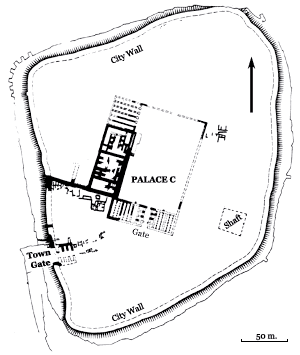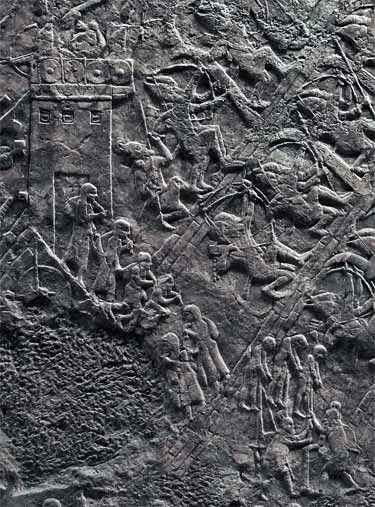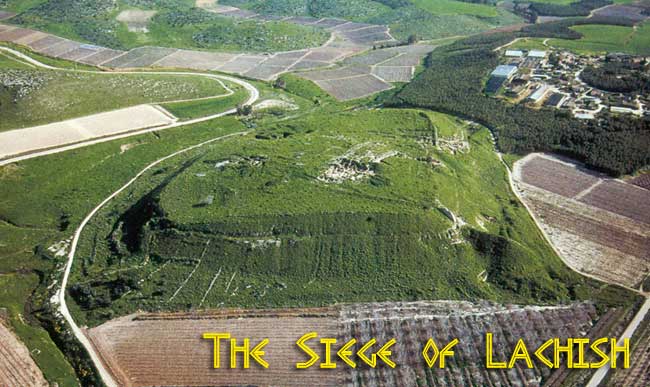
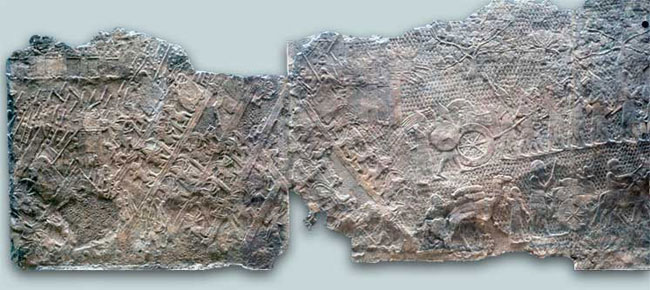
Slabs 7 & 8
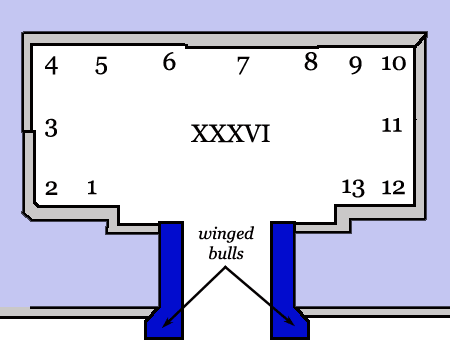
Location of Reliefs in Room XXXVI
As can be seen from the drawing below, the town of Lachish was a fortified stronghold of the kings of Judah at the mouth of a strategic pass leading up from the plain to the capital of Jerusalem up in the hills. Obviously, its capture was of vital importance to Sennacherib—undoubtedly accounting for its prominence in his new palace—this scene directly faced the visitor when he entered the room. The site has been identified with the ruins at Tell ed-Duweir and was excavated in the 1930s by a British expedition lead initially by James Starkey and, after he was killed by bandits in 1938, by Olga Tufnell. They identified Layer III (numbered from the top) as the town destroyed by the Assyrian king and excavated the palace at the top of the tell that served as a citadel.
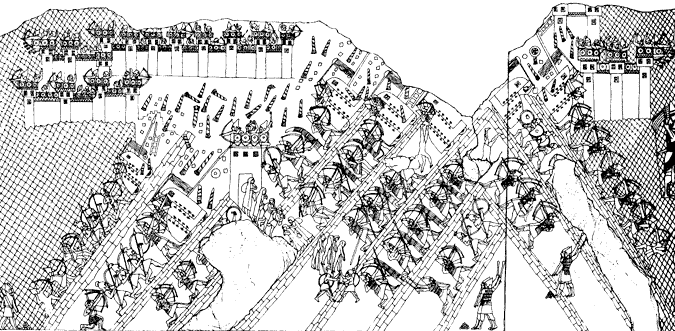
Lachish
The site of Lachish had been occupied for at least 2,000 years before Sennacherib showed up and the town now sat at the top of quite a high mound (Arabic: tell). To even get to the walls, Assyrian engineers had to build an enormous ramp up against the relatively low, south-western corner of the tell. This was the only real weak point in the defences (and it was not all that weak). The only road to the site ran along low ridge and led to a massive, fortified gate. When Israeli archaeologists began to re-investigate the site in the 1970s under the direction of David Ussishkin, one of the things they found was the remains of the ramp. It largely made out of stone—large boulders with an upper surface of smaller stones bonded with mortar which dried into a kind of concrete that still survives today.
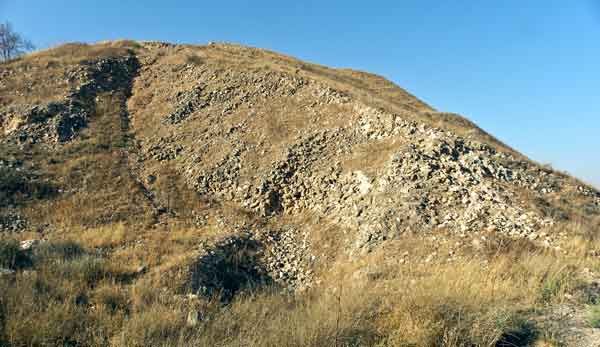
Remains of the Siege Ramp at Lachish (©Mark A. Wilson.Wikimedia Commons)
The reason for the pavement was that Sennacherib’s intention was to roll up heavy siege machines to destroy the walls. These were large, wheeled wooden contraptions from which a long wooden beam, tipped with a metal point, was suspended. This could have been swung against the wall but 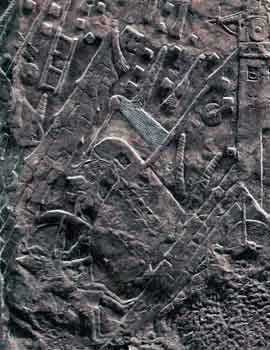 it seems more likely that it acted as an enormous pry bar, capable of moving in all directions to jimmy the brickwork loose, especially the lighter, upper part of the ramparts.
it seems more likely that it acted as an enormous pry bar, capable of moving in all directions to jimmy the brickwork loose, especially the lighter, upper part of the ramparts.
The ram and the men working it were protected by a canopy of heavy, oiled leather which would provide a hard shell, largely impervious to missles. It was also relatively flame-retardant—fortunate, considering the firebrands (presumably accompanied by vats of olive oil or some such flammable) being hurled down by the defenders. Each ‘battering ram’ apparently included a fire-fighting unit. In the detail (left), one of them is using a long ladle to quench a torch that has been hurled down into its path.
In earlier periods, Assyrian narrative reliefs had been episodic in nature, composed of a series of distinct scenes similar in layout to a comic strip, but, in this case, the whole story has been combined into a single scene. So, in the scene (opposite right), women and children are shown leaving the stricken city in the midst of a full-scale assault on its walls. The most common policy for dealing with rebel populations— the majority of them, anyway—was to exile them to another part of the empire and put them to work. Just such a fate awaited all of Israel within a few short years. As far as the leaders were concerned, it was a very different story. No mercy was shown to them at all and here we see their broken bodies being impaled on sharpened posts to serve as a warning to any other would-be rebel.
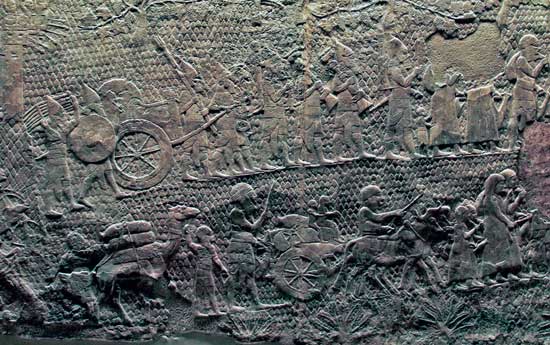
Assyrian troops carrying away booty while a procession of refugees heads into exile.
Another procession of refugees (above), with their personal possessions loaded onto the backs of camels or into ox carts are depicted moving away from the city to the right. Above them is shown a line of Assyrian soldiers under the command of an officer carrying away loot from the city including what appears to be a pair of incense altars. The rest of the men are carrying captured weapons to be dedicated to the god Ashur when they celebrate their victory back in the capital. These include spears, swords, shields and a chariot.

Location of Reliefs in Room XXXVI
Slabs 9 & 10
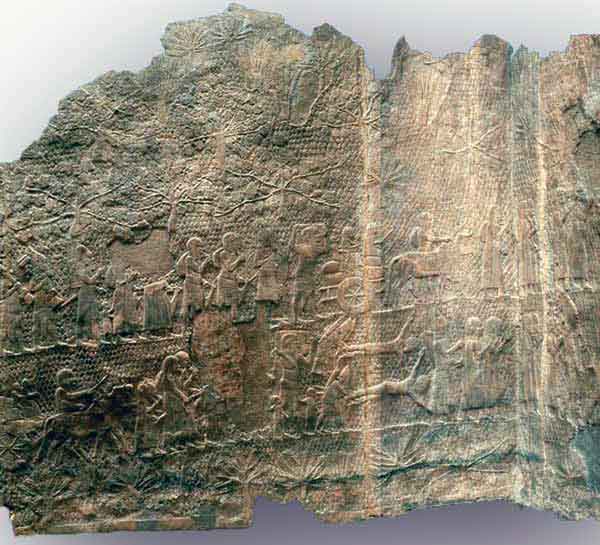
On the extreme right of the end wall is a particularly grisly scene as two of the town’s leading citizens are shown staked out on the ground and presumably about to be flayed by Assyrian soldiers—witnessed by their wives and daughters, as they pass by on their way into exile.

